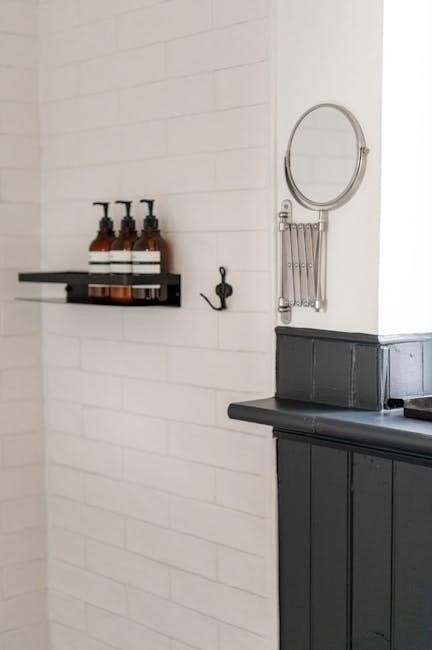Safety Precautions andWarnings
Always read instructions fully before starting assembly. Ensure weight limits are not exceeded, as specified in the product manual. Check for safety certifications to guarantee compliance with industry standards. Never assemble without proper tools, and keep loose clothing tied back. Ensure all parts are securely tightened to avoid instability.
1.1 Weight Limits and Safety Certifications
Always adhere to the specified weight limits for your futon bunk bed to ensure stability and safety. Typically, the weight capacity for the upper bunk is around 350 lbs, while the lower bunk may accommodate more. Check for safety certifications such as EN 747 or ASTM F1427, which ensure the product meets industry standards. Look for labels or documentation that confirm compliance with these certifications. Never exceed the recommended weight limits, as this can lead to structural failure. Ensure all components, including guardrails and ladders, are securely attached and meet safety guidelines. Refer to the product manual for specific weight limits and certification details. This ensures the bunk bed is safe for use and complies with regulatory requirements.
1.2 Essential Safety Tips Before Assembly
Before assembling your futon bunk bed, ensure the area is clear of obstacles and tripping hazards. Lay out all parts and tools in an organized manner to avoid misplacement. Wear protective gloves and eyewear to prevent injury from sharp edges or flying debris. Avoid working alone; having an assistant can help with heavy components. Double-check all components for damage before use. Follow the manufacturer’s instructions precisely and avoid improvising, as this can compromise safety. Ensure all bolts and screws are tightened properly to maintain structural integrity. Keep children and pets away from the assembly area to prevent accidents. Take regular breaks to maintain focus and avoid fatigue, which can lead to mistakes. Proper preparation ensures a safe and successful assembly process.

Preparation Before Assembly
Clear a spacious workspace, ensuring it is flat and stable. Gather all tools and materials as listed in the instructions. Unpack and organize parts carefully to avoid damage; Double-check that all components are included and undamaged. Read through the entire manual to understand the process before starting. Plan the assembly sequence to optimize efficiency and safety. Having a second person assist can simplify handling larger or heavier parts. Ensure good lighting and ventilation in the workspace. Lay out small hardware in labeled containers to prevent misplacement. Take a moment to mentally prepare for the task to ensure accuracy and patience.
2.1 Tools and Materials Needed
To assemble the futon bunk bed, you will need a set of basic tools, including an Allen wrench, screwdriver (both Phillips and flathead), and a hammer. Additional tools like a socket wrench or pliers may be required depending on the specific model. Ensure all materials provided in the package are included, such as bolts, screws, and metal frames. Check for any pre-drilled holes or alignment marks to simplify assembly. Refer to the instruction manual for a detailed list of required tools and materials. Organize parts by size and type to streamline the process. Having a second person assist can be helpful for handling larger components. Always verify the completeness of the hardware kit before starting.
2.2 Clearing the Workspace
Before assembling the futon bunk bed, ensure the workspace is clean and free from obstructions. Choose a flat, stable surface, preferably with enough room to lay out all parts. Remove any fragile or breakable items nearby to prevent damage. Cover the floor with a protective material like cardboard or a drop cloth to avoid scratches or spills. Clearing sufficient space will allow easy access to all components and tools. Properly organizing the area will prevent misplacing small parts and make assembly more efficient. A well-prepared workspace contributes to a smoother and less stressful assembly process. Always ensure good lighting to see instructions and parts clearly.

Step-by-Step Assembly Instructions
Follow the manufacturer’s instructions closely to ensure proper assembly. Begin by unpacking and organizing all parts. Attach the futon mechanism to the frame, then install guardrails for safety. Ensure all bolts are securely tightened. Lubricate moving parts to ensure smooth operation. Double-check each step to avoid errors.
3.1 Unpacking and Organizing Parts
Begin by carefully unpacking all components from the boxes. Lay out each part on a flat surface to ensure nothing is missing or damaged. Refer to the inventory list provided in the instructions to account for every item. Separate the parts into categories, such as frame components, hardware, and accessories. Label each group to streamline the assembly process. This step is crucial for efficiency and preventing delays. Additionally, check for any specific labels or markings on the parts that indicate their intended position or orientation. Organizing systematically will make following the instructions much easier. Take your time to ensure accuracy.
3.2 Assembling the Bunk Bed Frame
Start by attaching the legs to the main frame using the provided bolts. Ensure they are securely tightened to create a stable base. Next, connect the side rails to the top and bottom frames, aligning the pre-drilled holes carefully. Use the Allen wrench to tighten these connections firmly. Attach the support slats to the upper bunk, spacing them evenly as instructed. Double-check that all joints are tight and the frame is level. Refer to the weight limit specified in the manual to ensure safety. If any parts seem misaligned, stop and consult the instructions before proceeding. Proper assembly at this stage is critical for the overall stability of the bunk bed. Avoid over-tightening to prevent damage to the hardware.
3.3 Attaching the Futon Mechanism
To attach the futon mechanism, first align the metal brackets on the futon frame with the corresponding slots on the bunk bed. Gently slide the brackets into place, ensuring they click securely. Use the provided screws to fasten the mechanism, tightening them in a star pattern to maintain even pressure. Double-check that the mechanism moves smoothly, folding up and down without resistance. If it feels stiff, apply a small amount of silicone-based lubricant to the hinges. Test the mechanism several times to ensure proper functionality. Make sure all bolts are tightened firmly to prevent any shifting during use. Proper installation ensures the futon operates safely and efficiently. Always follow the manufacturer’s specific torque settings to avoid over-tightening.
3.4 Installing Guardrails and Safety Features
Begin by identifying the guardrail components in the packaging. Attach the side guardrails to the bunk bed frame using the provided screws, ensuring they align with the pre-drilled holes. Tighten the screws firmly but avoid over-tightening, which may strip the threads. Next, install the safety ladder guardrail to prevent access from the lower bunk. Double-check that all guardrails are securely fastened and evenly spaced. Test the stability of the guardrails by gently applying pressure. Ensure the guardrails extend at least 5 inches above the mattress surface for optimal safety. Finally, verify that all safety features comply with industry standards to prevent accidents and ensure a secure sleeping environment. Regularly inspect the guardrails for any signs of wear or loosening.
3.5 Final Tightening and Inspection
Once all components are assembled, perform a thorough inspection. Check every bolt, screw, and joint to ensure they are securely tightened. Use a wrench or screwdriver to tighten any loose connections. Pay particular attention to the futon mechanism and guardrails, as these are critical for safety and functionality. Inspect the frame for any signs of damage or misalignment. Test the bunk bed by gently rocking it to ensure stability. Finally, double-check that all safety features, such as guardrails and ladders, are properly secured. This final step ensures the bunk bed is safe and ready for use, providing peace of mind for years to come. Regular inspections are recommended to maintain its integrity.
Maintenance and Care
Regularly vacuum the frame and mattress to prevent dust buildup. Oil hinges and moving parts to ensure smooth operation. Avoid harsh chemicals; use mild detergents for cleaning.
4.1 Cleaning the Futon and Frame
To maintain your futon bunk bed, regularly clean the frame and mattress. Use a soft brush to remove dust and debris from the frame. For the futon, vacuum both sides to eliminate dust mites and allergens. Spot clean stains with a damp cloth and mild detergent, avoiding harsh chemicals. Allow the futon to air dry completely before reuse. For metal frames, wipe with a dry cloth to prevent rust. Avoid using abrasive cleaners or scrubbers, as they may damage the finish. Regular cleaning ensures longevity and hygiene, keeping your futon bunk bed in excellent condition for years to come.
4.2 Lubricating Moving Parts
Regular lubrication of moving parts ensures smooth operation and prevents wear. Apply a small amount of silicone-based lubricant to hinges, joints, and mechanisms. Avoid using oil or grease, as they can attract dust. Wipe off excess lubricant with a clean cloth to prevent drips. Lubricate every 6-12 months or when creaking occurs. Pay special attention to the futon mechanism, ensuring all moving components are well-lubricated. This maintenance step prolongs the lifespan of your bunk bed and keeps it functioning effortlessly. Always refer to the manufacturer’s recommendations for specific lubrication needs. Proper care ensures optimal performance and safety.

Choosing the Right Mattress

Select a mattress compatible with both the bunk and futon, ensuring proper fit and support. Opt for a standard full-size futon mattress for the lower bunk. Always check weight limits to ensure safety and prevent structural strain. Choose a mattress with adequate thickness for comfort while fitting within guardrail height requirements. Consider memory foam or innerspring options for optimal support. Ensure the mattress is specifically designed for futon bunk beds to guarantee compatibility and durability.
5.1 Size and Thickness Requirements
The mattress must fit snugly within the frame to ensure safety and comfort. For a standard futon bunk bed, a full-size mattress is typically recommended, measuring 54 inches wide and 75 inches long. Thickness should not exceed 10 inches to allow proper closure of the futon mechanism; A thinner mattress, around 6-8 inches, is ideal for easy conversion between sofa and bed modes. Always refer to the manufacturer’s specifications for exact dimensions to avoid compatibility issues. Proper sizing ensures the mattress stays securely in place and supports the weight limits of the bunk bed. This prevents sagging and enhances overall durability.
5.2 Recommended Mattress Types
For optimal comfort and functionality, choose a mattress specifically designed for futon bunk beds. Memory foam mattresses are ideal due to their ability to conform to the body and provide excellent support. Innerspring mattresses are another popular choice, offering durability and breathability. Hybrid mattresses, combining foam and innerspring, are also suitable for their balanced support and pressure relief. Avoid overly thick mattresses, as they may hinder the futon mechanism’s functionality. Ensure the mattress is compatible with the bed’s size and weight capacity. Always consult the manufacturer’s guidelines for specific recommendations tailored to your bunk bed model. Proper mattress selection ensures both safety and comfort for users.

Troubleshooting Common Issues
If the frame feels unstable, check for loose bolts and tighten them. For issues with the futon mechanism, ensure all parts are properly aligned and secured.
A wobbly frame can be addressed by checking all bolts and screws for tightness. Ensure the bed is placed on a level surface. If instability persists, inspect the joints and connections for any damage or misalignment. Tighten any loose fasteners firmly. If the issue remains, consider reinforcing the legs or base with additional support brackets. Always refer to the manufacturer’s guidelines for specific solutions tailored to your model. Regular maintenance can prevent such issues from arising. To ensure smooth operation, periodically inspect and adjust the futon mechanism. Lubricate hinges and moving parts with silicone spray to maintain ease of use. If the futon feels stiff or uneven, check the alignment of the frame and adjust the hinges as needed. Tighten any loose screws or bolts that may affect the mechanism’s performance. For optimal functionality, ensure the mattress is properly sized and aligned with the frame. Refer to the manufacturer’s instructions for specific adjustment procedures. Regular maintenance will prevent issues and extend the lifespan of the futon bunk bed. Always test the mechanism after adjustments to ensure it operates safely and efficiently.6;1 Fixing Wobbly Frames

6.2 Adjusting the Futon Mechanism
